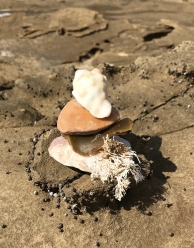by Mary Tracy, formerly of AWC Bogotá
The New Year of 2020 seems a perfect opportunity to clearly consider not just what we want to accomplish or do differently, but also what we already have and are already doing that functions as effective self-care. Before setting resolutions to establish certain new habits or accomplish specific goals, it can be good to first take stock both of ourselves and of our world.
As for our world, we are living in an era of health awareness that is overly full of ways to engage in self-care by being mindful about what we eat and drink, how we treat our bodies, the effect we have on those around us, how we manage the earth’s finite resources and how we increase the balance of peace and joy in our days. Rather ironically, it can be stressful to consider the increasing choices we have in caring for ourselves, even after we have made a conscious decision to do so.
Next, to take stock of ourselves...
 To those of you who have already found a reliable method of reclaiming and regularly attending to your center of wellness, bravo! Your task is to maintain this discipline you have established, to remember how to return to it when you find yourself getting knocked off center and finally, to remain mindful that even the most reliable spiritual disciplines go through seasons and may need updating or cross-training now and then when they begin to run dry.
To those of you who have already found a reliable method of reclaiming and regularly attending to your center of wellness, bravo! Your task is to maintain this discipline you have established, to remember how to return to it when you find yourself getting knocked off center and finally, to remain mindful that even the most reliable spiritual disciplines go through seasons and may need updating or cross-training now and then when they begin to run dry.
To the rest of us, this is an invitation to consider some basic questions about how to increase the balance of joy and peace in your day. First, it can be helpful to reflect back on a time when you remember being more satisfied, mindful or otherwise having more symptoms of joy and peace, such as frequent good-natured laughter, dancing, an abiding sense of well-being, clarity of thought and purpose, clarity of self-identity. Is there a spiritual discipline you had in your past that you have forgotten that might help you now?
Second, it can also be illuminating to consider some of the alternative healing modalities out there that can help with the diagnosis, treatment and management of both specific issues and general well-being. These are not replacements for other practices that can nourish the soul, such as meditation, gardening, cooking for pleasure and having coffee with a friend; however, they can be helpful in speeding up the process of getting back on track with self-care and wellness.
Furthermore, consider also the wellness benefit of being unwell: it can open us, make us more aware of our needs and vulnerabilities, and help us identify issues we otherwise would not have noticed. Un-wellness of any sort can be the soul’s way of drawing our attention to a crucial lack or a new opportunity in our daily life. Taken as an invitation to get curious, such challenges can help us find new, more effective sources of healing.
So, let’s consider some of the self-care resources out there.
First, a few helpful facts, terms and distinctions… A quick online search for “academic integrative centers” yields at least 27 such institutes or centers around the US and Canada alone focused on researching, diagnosing and/or treating specific conditions and on general well-being, drawing from a wide variety of complementary and alternative healing modalities and practices. These include centers associated with Johns Hopkins University, the Mayo Clinic, Duke University, Stanford University, the Canadian Institute of Natural and Integrative Medicine, Cleveland Clinic and the George Washington Center, to name a few.
According to the National Institutes of Health website for the National Center for Complementary and Integrative Health (NCCIH), “complementary” refers to non-conventional healing modalities used together with more conventional treatments, while “alternative” refers to such non-conventional healing modalities in place of traditional treatments. “Integrative” refers to a coordinated use of conventional and complementary treatment modalities. A quick review of various sites, including the NIH’s NCCIH, turned up the following general categories:
Traditional Alternative Medicine: Including acupuncture, Ayurveda, homeopathy, naturopathy and Chinese medicine, these are all systems of diagnosis and treatment that go back centuries and include a variety of subsets within each tradition. For example, some acupuncture therapists are trained to focus on maintaining overall well-being, while others have pivoted to focus more on diagnosing and treating specific problems like sleep issues and smoking cessation. There is also significant overlap between these different systems. For example, naturopathy can incorporate acupuncture, Chinese medicine and other practices in order to remove obstacles and facilitate the body’s inclination to heal itself.
 Mind and Body Practices: These practices aim to create a greater sense of synchronicity between mind, body and spirit. Each of these focuses on energy work, such as reiki, Healing Touch, qi gong, tai chi, acupuncture and acupressure. The NIH site for NCCIH includes additional examples of mind-body techniques, such as meditation, prayer, relaxation, yoga, music and animal-assisted therapy. As with traditional alternative medicine, there is much overlap both in content and general philosophy.
Mind and Body Practices: These practices aim to create a greater sense of synchronicity between mind, body and spirit. Each of these focuses on energy work, such as reiki, Healing Touch, qi gong, tai chi, acupuncture and acupressure. The NIH site for NCCIH includes additional examples of mind-body techniques, such as meditation, prayer, relaxation, yoga, music and animal-assisted therapy. As with traditional alternative medicine, there is much overlap both in content and general philosophy.
Sensory Techniques: One additional group sometimes acknowledged by integrative centers includes music/dance therapy, art therapy, visualization or guided imagery. Creating and coloring mandalas or joining a drumming circle can be therapeutic for some people, in a supportive, healthy environment.
As with any self-care or medical practices, it is good to consult a variety of sources including personal, professional and academic if possible. See, for example, an NIH article on assessing the trustworthiness of integrative strategies and professionals: Credible Complementary and Alternative Medicine Websites.
Increasing your own personal wellness is an act of kindness not only to yourself but also to the world. It is certainly worth the effort to explore until you find self-care strategies and disciplines that fit the you of 2020.
(Photo credits: Tharien van Eck)
